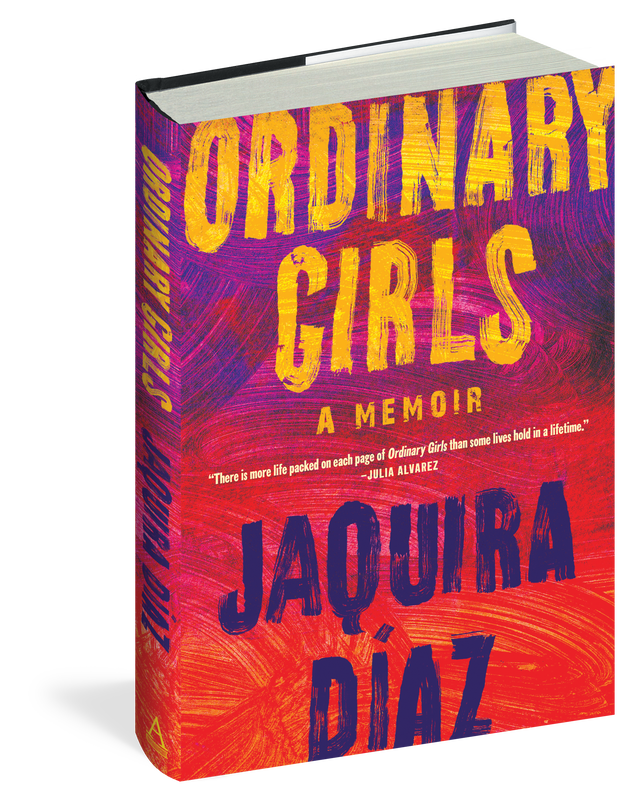Editor’s Note: This post contains affiliate links. Learn more about our affiliate policy.
Written by: Justin Edmund Watkins
Jaquira Díaz’s “Ordinary Girls” is a memoir of the author’s tumultuous life battling some pretty strong inner and outer demons. Jaqui, as she’s called, was born poor in rural Puerto Rico to a very young white mother and a failed intellectual black father who mostly makes money selling drugs.
Her black abuela helps raise her. After moving a few times within Puerto Rico, the ramifications of her father’s dealings finally catch up with him, and the family moves to Miami. The dissolution of her parents’ marriage, her mother’s descent into schizophrenia and substance abuse, and the author’s own foray into the chaotic world of drug abuse, attempted rape, depression, love, sex, and recurring suicide attempts plague her upbringing in Miami.
Despite her youth under many dark influences, she finds solace in her “girls.” Some girls in her circle come from similar instability and some have traditional upbringings. Through the strength, determination, and love of her girls, Jaqui eventually banishes her demons without ever explicitly defining a particular life-changing moment or hitting a proverbial rock bottom.
She then achieves measures of success, including graduation from university, prestigious awards, and a career as a freelance writer. The beauty of a memoir is that the author can convey her feelings in a more profound way based on personal experiences. Díaz’s Ordinary Girls grants readers a sense of intimate access to her welter of experiences, leaving a vivid impression of how she felt in the moment.
She recounts her childhood and adolescence in a language code that switches between English and Spanish. Specific place names in Puerto Rico and Miami pepper her prose to establish the authors’ concrete identification with particular, recognizable locations.
She also anchors the memoir to a specific period in the South Florida news cycle, with incidents such as a French woman committing suicide by leaping from her father’s building and the infamous “Baby Lollipops” case of a murdered toddler found in the bushes of her neighborhood.
Ordinary Girls weaves together the details of local news with first-hand memories, context with individual chronologies. Whether she is fleeing a machete-wielding neighbor in Puerto Rico as a young girl, exposing her budding breasts to a much older boy alone in a girls’ locker room at age eleven, nearly being raped by an older man a few years later and being rescued by her friends, or deciding to swallow a bottle of her mother’s pills and hoping not to ever wake up, Díaz offers a compilation of memorable anecdotes that shaped her girlhood.
In a characteristic example of her prose style, Díaz recounts one suicide attempt: “I got up a few hours later and took my mother’s pills, all of them—antipsychotics, sleeping pills, anxiety pills. I washed them down with half a bottle of Dawn dishwashing liquid […] I was determined to die.” She lives to tell the tale. With stark determination, she lays out details in a raw, matter-of-fact incantation to convey dark, watershed moments of her adolescence.
Díaz’s style reflects the scattering effect of substance abuse that she was all-too-familiar with during her formative years. The events of Ordinary Girls do not follow an ordinary sequence of succession. In fact, the chronology is disjointed, sometimes leaving gaps between events years apart or revisiting an event that has already been told in part.
This technique adds another layer of insight because it parallels the disjointed nature of the author’s life, her feelings, and her soul during these times. The chaos of Díaz’s coming-of-age sits uneasily alongside the book’s title. By calling her memoir of an uncommon childhood “Ordinary Girls,” Díaz proposes to extend her individual experience to both more common and idiosyncratic experiences of girls more widely.
At the end of the book, she writes of ordinary girls:
“This is who I write about and who I write for. For the girls they were, for the girl I was, for girls everywhere who are just like we used to be. For the black and brown girls. For the girls on the merrygo- round making the world spin. For the wild girls and the party girls, the loudmouths and the troublemakers. For the girls who are angry and lost. For the girls who never saw themselves in books.”
All of these girls encompassed here seem to be misfits, trying to find their way through life. For Díaz this is what it means to be an “ordinary girl”: a girl who is just trying to get through life given her particular set of circumstances. Given that her own lived experience deviates from the norm, Díaz derives her authority from her unique experiences, which she recognizes as valid, worth telling and worth reading.
She extends this validation to the individual yet collective experiences of all girls. Composing this memoir in mid-life, Díaz writes as a survivor of her childhood and adolescence, as an author who has achieved the understanding that all girls’ experiences are different and all fundamentally valid.
Through the ups and downs of her extra-ordinary life growing up in Miami, through the very act of recollection and retelling, Díaz proclaims to these girls that they matter, simply by allowing them to be part of the ‘ordinary,’ showing that there are always other girls out there with experiences worth telling. I consider this kind of feminine validation is especially important for ordinary girls struggling with their own self-worth as they live out their own extraordinary stories.
Get the book:
You may also like
-
J Balvin Deslumbra en Orlando en su gira “Back to the Rayo”
-
Orange County Government Announces Events Celebrating Asian American and Pacific Islander Heritage Month
-
CALENDARIO DE EVENTOS
-
Entendiendo el Atractivo de los Dramas de Narcotráfico como Colombiana Viendo “Griselda”
-
Reconciling the Allure of Drug Dramas as a Colombian watching “Griselda”
















